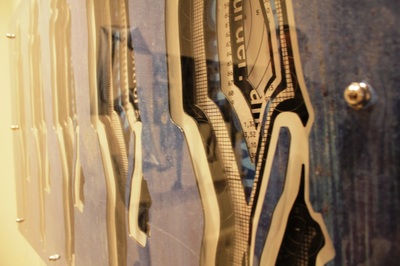
Jane Maxwell began her career as an artist at about the same time as another notable life changing event: she became a mom.
“I had two little girls very close in age, and like most girls, they played with dolls – including paper doll cut-outs. I had been an avid collector of all sorts of paper including a collection of paper doll kits. I watched as my girls sat mesmerized by these little one-dimensional dolls, carefully changing their perfectly fitting little paper dresses,” says Maxwell. “It dawned on me that they were being set up for a rude awakening - when they realized that living as a woman in our world today, wasn’t quite as simple as these perfect little dolls seemed to suggest. My very first art series was based on the deconstruction of those paper doll cut-out forms. From those very first paper doll pieces, I began exploring different female forms from the 50’s pin-up to the runway model to red carpet celebrities.”
Maxwell, a mixed media artist from Boston, says she was always drawn to visual imagery; prints, vintage paper, interior design and just about anything hanging in friend's homes. But this didn't point her in the direction of "professional artist" until her daughters gave her this focus.
Find Out More About Jane Maxwell HERE
“I am often asked if I have a political motivation or am trying to make a feminist statement with my art. I wish I could say that I was. Instead, my art is really more of a personal expression of my own ambivalence about what it means to live in a culture where there is an inherent pressure to conform to a specific feminine ideal,” she says. “I both wholeheartedly engage in all the behaviors that perpetuate the myth – I try new beauty products, read pop culture magazines, purchase the trendy fashion. And, yet, I feel the pressure and resent this idea that I must seek perpetual perfection.”
These works—and viewers can see this without having an MFA—are essentially blueprints of women. Maxwell says this is because the message is inherent; many women struggle with this issue.
“There is a US epidemic of women unhappy with their bodies, and who struggle with what it means to be a woman today.” she says.
The work is often paper-based, although when you see it this may not be readily apparent. Layers of paper, wax and resin make the pieces three dimensional. And the paper generally isn't just off the rack from an art store.
“I work almost exclusively with found and vintage papers. I like the way these materials have their own history and unique patina. I am particularly drawn to vintage movie posters, old ledger books, children’s workbooks and anything with numbers and charts. I am interested in experimenting with how these materials can be manipulated - layered, glued down, and peeled back,” says Maxwell. “My process begins with a panel canvas. I typically glue up to 5 or 6 layers of unique papers to create the base of the piece. I will use a variety of ‘templates’ to create the figures through a process of decollage. I then continue to build up and peel back layers – always surprised at what text and imagery I can unearth. It’s a bit of an excavation process.”
“While everyone else in the class built their colored paintings, I began experimenting with papers layered with glue and wax,” she says. “I continue to use beeswax throughout my process today.”
When work deals with gender issues, be that work political or personal, men and women often look at it differently. Maxwell says it is hard to generalize about how men and women see her work but there are some interesting things she has noticed.
“I would say that the big difference that I have noticed, is that men see the work more as a compositional whole, while women tend to focus on the layering and finer detail of the work. For example, often I tuck old weight watchers logs and other diet/exercise related papers into the work. The women always find them right away (the guys never do!),” she says. “I also find that for women, the work often triggers feelings of longing or nostalgia – usually for their sisters, daughters of girlfriends. Or they feel empowered by the strong poses of the women and their ‘take charge’ attitude.”
See More Work Via Caldwell Snyder Gallery (San Francisco/St. Helena)
“My work is really a collaboration of many of my interests – fashion, textiles, interiors, color, pattern and pop culture and how those things help quiet my internal world,” she says. “In other words, I think my art is a working through of how I use superficial or exterior stimuli to assuage or cope with my interior world – issues around feelings of pressure, anxiety, competition, rage, envy sadness and so on.”
While she says it is difficult to tell where her work will head next she does have some ideas.
“I have had a lot of fun jumping off the canvas and working sculpturally. That has been an enormous shift for me. I hope to continue to explore more in the 3D realm. I have also been thinking a lot about human connection,” says Maxwell. “Much of my work up to this point has been focused on the individual woman and her (my) experience. I am starting to think it would be interesting to create more direct interaction between figures on the canvas – between both men and women.”




 RSS Feed
RSS Feed